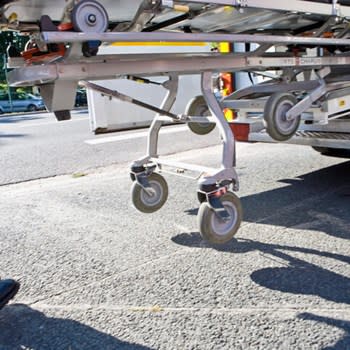Does Medicaid Cover Life Alert Devices and Monitoring?
- Does Medicaid cover life alert devices and monitoring? It depends on what type of Medicaid you have. Read on to learn more about emergency monitoring coverage.
Personal alert devices make it easy for older adults to get help in emergency situations. Each device has a call button to connect the user with dispatchers, reducing the amount of time it takes to get help from paramedics after a fall or some type of medical event. Whether you're interested in Life Alert or another type of device, it's important to choose something affordable. So, does Medicaid cover Life Alert devices and monitoring? The answer depends on where you live and what type of Medicaid coverage you have.

Learn More About Medicare
Join our email series to receive your free Medicare guide and the latest information about Medicare.
By clicking "Sign me up!" you are agreeing to receive emails from HelpAdvisor.com
Thanks for signing up!
Your free Medicare guide is on the way.
Make sure to check your spam folder if you don't see it.
Types of Personal Alert Devices
The right device for your needs depends partly on whether you have a landline or a cellular telephone. Personal alert systems were originally designed for landlines, but they've been updated to ensure that people who rely on their cell phones can still take advantage of the benefits of emergency monitoring.
One advantage of choosing a mobile system is that you can use it even when you leave the house. If you fall while visiting a friend, for example, you can still get help quickly.
Although many devices are monitored, some companies sell personal alert systems that aren't monitored by dispatchers. Instead, pressing the button allows the user to connect with a friend or family member. Choosing an unmonitored device can help you save money, but you won't have the peace of mind of knowing that emergency services are always just the push of a button away.
Does Medicaid Cover Life Alert Under the Money Follows the Person Program?
Medicaid's Money Follows the Person program aims to help older adults remain in their own homes or in community settings for as long as possible. The program makes funds available to help Medicaid enrollees receive necessary services and supports, allowing them to maintain their independence and quality of life.
As of 2023, 43 states and the District of Columbia participate in this program; however, nine states have run out of MFP funding, leaving Medicaid beneficiaries in those states unsure of how they will pay for emergency monitoring and other services.
Medicaid Consumer Directed Services
In some states, Medicaid distributes funds to enrollees and allows them to determine how the money should be spent. This is known as the Consumer-Directed Services program or Self-Directed Services program.
If you qualify for this program, you may be able to use the funds to pay for a Life Alert system and ongoing monitoring. You'll have the opportunity to draw up a written service plan and get help from people you trust as you work to determine the best way to use your Medicaid funds.
Does Medicaid Cover Life Alert Under Any Waiver Programs?
Many states have waiver programs to help Medicaid enrollees access the services they need to stay in their communities. This type of program allows states to "waive" certain eligibility requirements, ensuring you get the support you need even if you wouldn't normally qualify for Medicaid coverage.
Each state is responsible for setting up its own waiver program, so the benefits covered in one state may not be covered in another state, or they may be covered at a lower level. Many waiver programs cover personal alert services.
Medicaid Personal Care Attendant Programs
If you qualify for a Medicaid PCA program, you may be able to use your benefits to pay for a Life Alert device and ongoing monitoring fees. PCA programs are designed to help Medicaid beneficiaries remain in their communities for as long as possible, so many programs pay for emergency monitoring and other services that can keep an older adult safe at home.
Paying for these services may prevent some enrollees from entering nursing homes, keeping Medicaid costs as low as possible.
State Medicaid Programs
So, does Medicaid cover Life Alert? As you can see, it depends on where you live and whether you qualify for full Medicaid coverage or some type of waiver program. If you need emergency monitoring, one of these state programs may be able to help.
- Alabama: State of Alabama Independent Living (SAIL) Waiver or Alabama Community Transition (ACT) Waiver
- Alaska: Alaskans Living Independently
- Arizona: Agency With Choice Program or Arizona Long-Term Care System
- Arkansas: ARChoices Program or Independent Choices
- California: Multipurpose Senior Services Program or Home and Community-Based Alternatives Waiver
- Colorado: Elderly, Blind and Disabled Waiver
- Connecticut: Personal Care Assistance Program
- Delaware: Diamond State Health Plan Plus
- District of Columbia: Elderly and Persons with Disabilities Waiver
- Florida: State Medicaid Managed Long-Term Care
- Georgia: Community Care Services Program or SOURCE
- Hawaii: Med-QUEST
- Idaho: Aged & Disabled Waiver
- Illinois: Medicaid-Medicare Alignment Initiative, HealthChoice Illinois, Community Care, HCBS Waiver for Supported Living or HCBS Services for Persons Who Are Elderly
- Indiana: Aged and Disabled Waiver
- Iowa: HCBS Elderly Waiver
- Kansas: HCBS Waiver for the Frail Elderly
- Kentucky: Home and Community-Based Waiver or Supports for Community Living Waiver
- Louisiana: Community Choices Waiver
- Maine: Elderly and Adults with Disabilities
- Maryland: Increased Community Services Program, Community First Choice Program or Community Options Waiver
- Massachusetts: Frail Elder Waiver
- Michigan: Health Link Program or MI Choice Waiver
- Minnesota: Community Access for Disability Inclusion Waiver or Elderly Waiver
- Mississippi: Assisted Living Waiver
- Montana: Self-Direction Waiver or HCBS Waiver
- Nebraska: Aged and Disabled Waiver
- Nevada: Waiver for Persons with Physical Disabilities or HCBS Waiver for the Frail Elderly
- New Hampshire: Choices for Independence
- New Jersey: Personal Preference Program or Managed Long-Term Services and Supports
- New Mexico: Centennial Care Community Benefit
- New York: Community First Choice Option, Assisted Living Program or Long-Term Home Health Care Program
- North Carolina: Community Alternatives Program for Disabled Adults
- North Dakota: HCBS Medicaid Waiver
- Ohio: MyCare Ohio or PASSPORT Waiver
- Oklahoma: ADvantage Program
- Oregon: K Plan
- Pennsylvania: HealthChoices Program, Services My Way or HCBW for Individuals Aged 60 and Over
- Rhode Island: Global Consumer Choice Compact
- South Carolina: Community Choices Waiver
- South Dakota: HOPE Waiver
- Tennessee: CHOICES
- Texas: Community First Choice Program or STAR+PLUS Waiver
- Utah: Aging Waiver or UT New Choices Waiver
- Vermont: Choices for Care Moderate Needs Group or Global Commitment to Health Waiver
- Virginia: Commonwealth Coordinated Care Plus Waiver
- Washington: Medicaid Alternative Care Program, COPES, New Freedom Program or Community First Choice Option
- Wisconsin: Family Care or IRIS
- Wyoming: Community Choices Waiver






